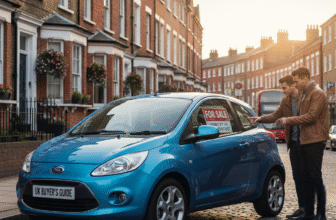
The Ultimate Guide to Buying Classic Cars on eBay UK: From Dream to Driveway
There’s a certain magic to a classic car. It’s more than just metal, rubber, and glass; it’s a time machine, a rolling piece of history, a tangible connection to a bygone era of motoring. For many enthusiasts in the United Kingdom, the dream of owning a classic—be it a jaunty MGB Roadster for sunny B-road blasts, a stately Jaguar for elegant cruising, or a humble Ford Cortina that dad used to drive—is a powerful one. In the digital age, the world’s biggest marketplace, eBay, has become one of the most popular, and sometimes perilous, places to turn that dream into a reality. The sheer volume of classic cars for sale on eBay at any given moment is staggering, offering a selection that no physical showroom could ever hope to match. But how do you navigate this vast digital forecourt to find your perfect classic without falling into a potential money pit? This comprehensive guide is here to steer you through the entire process, from the initial spark of an idea to the glorious moment you turn the key in your very own classic for the first time.
Why Choose eBay for Your Classic Car Adventure?
Before we dive into the nuts and bolts of the buying process, it’s worth considering why eBay has become such a dominant force in the classic car market. Its appeal lies in a unique combination of factors that cater to both seasoned collectors and first-time buyers.
The Unrivalled Selection

Where else can you, in a single evening from the comfort of your sofa, browse a concours-condition E-Type, a half-finished restoration project for a Triumph Spitfire, a rare barn-find Morris Minor, and a pristine, low-mileage Rover 75? eBay’s platform brings together private sellers from every corner of the UK, specialist dealers, and even those who are simply clearing out a relative’s garage. This creates a diverse and ever-changing inventory of vehicles, from pre-war tourers to modern classics of the 80s and 90s. Whether your budget is £1,500 or £150,000, there is almost certainly something to catch your eye.
The Thrill of the Auction
For many, the auction format is a significant part of the allure. The excitement of watching the bids climb in the final minutes and the potential to snag a genuine bargain is a powerful draw. An auction can often reflect a car’s true market value more accurately than a fixed dealer price. If you do your homework and set a firm limit, you can sometimes acquire a fantastic vehicle for significantly less than you might pay through traditional channels.
Convenience and Accessibility
The ability to search, compare, and inspect dozens of potential cars without leaving your home is a modern luxury. You can filter your search by make, model, year, location, price, and more, honing in on exactly what you’re looking for with a few clicks. This initial Browse phase allows you to get a feel for the market, understand pricing, and identify potential candidates for a closer look.
Mastering the Search: How to Find Your Perfect Classic
A successful eBay purchase begins with a smart search. Simply typing “classic car” into the search bar will yield a bewildering number of results. To avoid being overwhelmed, you need a more refined approach.
Be Specific with Your Keywords
If you have a specific car in mind, use its full name, including any relevant model designations (e.g., “Ford Escort Mk2 Ghia” or “Triumph TR6 Overdrive”). If you’re more open-minded, you can try broader terms like “classic British sports car” or “classic 1970s saloon.” Think about common misspellings or alternative names for the car and try searching for those as well. Sometimes a poorly titled listing can be a hidden gem with fewer bidders.
Leverage the Power of Filters
The filter options on the left-hand side of the search results are your best friend. The most important filter for a UK buyer is “Item Location.” You can set a distance from your postcode, which is absolutely crucial. Buying a classic car is a significant investment, and you should almost never buy one sight-unseen. Filtering by location allows you to find cars that are realistically within travel distance for a viewing. You can also filter by “Buying Format” to choose between “Auction” and “Buy It Now” listings, and set a price range to match your budget.
Set Up Saved Searches
If you’re hunting for a specific or particularly rare model, don’t forget to use the “Save this search” feature. eBay will then email you whenever a new listing that matches your criteria is posted. This automates the process and ensures you don’t miss out on the perfect car simply because you didn’t happen to be looking that day.
Decoding the Listing: Becoming an eBay Detective
Once you’ve found a promising-looking car, it’s time to put on your detective hat and scrutinise the listing in forensic detail. A seller’s listing tells you not only about the car but also about the seller themselves.
The Description is King
Read every single word of the description, then read it again. A good, honest seller will provide a wealth of information. Look for details on:
- History: How long have they owned it? Do they know its previous history? Is there a folder of receipts and old MOTs?
- Mechanical Condition: When was it last serviced? What work has been done recently (e.g., new clutch, brake overhaul, engine rebuild)? Are there any known mechanical faults?
- Bodywork Condition: Has it been restored? If so, when and to what standard? Are there photos of the restoration? Crucially, are they honest about any rust, dents, or paint blemishes? Phrases like “age-related marks” are common, but a good seller will specify what and where they are.
- Interior Condition: Is the upholstery original? Are there any rips or tears? Does everything work as it should (gauges, switches, heater)?
- The Reason for Sale: A genuine reason like “loss of storage,” “funding another project,” or “lack of use” is often a good sign. Be wary of vague or non-existent reasons.
Red flags in a description include extreme brevity, an over-reliance on phrases like “sold as seen” or “spares or repair” (unless that’s what you’re looking for), and an ALL CAPS writing style that can suggest a certain level of desperation or unprofessionalism.
A Picture is Worth a Thousand Pounds
Photos are your first real inspection of the car. A seller who is proud of their vehicle will provide numerous high-resolution photos from every conceivable angle. You should be looking for:
- Overall Shots: Clear shots of all four sides, plus front and rear three-quarter views, taken in good daylight on a dry day.
- Close-Ups of Key Areas: Pay close attention to known rust spots for that particular model. This typically includes wheel arches, sills (the area below the doors), jacking points, boot floor, and the bottoms of the doors.
- The Underside: Photos of the chassis and floorpans are a huge bonus. A seller willing to show you the underside is likely a confident one.
- The Engine Bay: Does it look clean and well-maintained, or is it a mess of oil leaks and bodged wiring?
- The Interior: Clear shots of the seats, dashboard, headlining, and carpets.
Be suspicious of listings with only a few, blurry, or distant photos. Pictures taken in the rain can hide a multitude of sins, making tired paintwork look glossy and disguising blemishes.
Investigate the Seller
Don’t forget to check the seller’s feedback profile. Click on their username to see their feedback score and, more importantly, read the comments left by other buyers. Have they sold cars or high-value items before? A long-standing member with 100% positive feedback from selling similar items is a much safer bet than a brand-new user with a zero score.
The Golden Rule: Due Diligence Before You Bid
You’ve found a car that ticks all the boxes. The description is detailed, the photos are great, and the seller seems reputable. Now comes the most critical phase of all: your pre-purchase due diligence. Skipping these steps is the fastest way to turn a dream into a nightmare.
Ask, Ask, and Ask Again
Use the “Ask a question” link on the listing page. Formulate polite, specific questions based on your analysis of the listing. For example: “Hello, the car looks lovely. Could you please tell me if there is any play in the steering?” or “I see from the MOT history that there was an advisory for corrosion on a brake pipe two years ago. Do you know if this was rectified?” A genuine seller will be happy to provide detailed answers. Evasive or rude replies are a major red flag.
Arrange a Viewing (This is Non-Negotiable)
For any significant amount of money, you must view the car in person. If the seller refuses a viewing, walk away. No excuses. It’s the biggest red flag in the book. When you go for a viewing, try to take a friend who is knowledgeable about cars, or even better, a professional inspector. Check the car’s V5C (logbook) and ensure the Vehicle Identification Number (VIN) on the document matches the one on the car’s chassis plate. Take your time. Don’t be rushed. This is your chance to verify everything in the listing and uncover anything that wasn’t mentioned.
Conduct a Vehicle History Check
Services like HPI Check or Experian AutoCheck are invaluable. For a small fee, you can use the car’s registration number to check for crucial information, including:
- Whether the car has outstanding finance.
- If it has been reported as stolen.
- If it has been declared an insurance write-off (e.g., Category S or N).
- Any mileage discrepancies.
Buying a car with a hidden history can have serious legal and financial consequences. This check is an absolute must.
Check the MOT History Online
The UK Government provides a free online service to check a vehicle’s MOT history. All you need is the registration number. This database is a goldmine of information. It shows you not only if the car passed or failed its MOTs but also lists all the “advisory notices.” A long list of advisories for corrosion, oil leaks, or worn suspension components, even on a car with a current MOT, can be a warning of expensive bills to come.
The Final Steps: Bidding, Buying, and Bringing it Home
With your due diligence complete, you can now proceed with confidence.
Auction and Bidding Strategy
If the car is in an auction, decide on your absolute maximum price and stick to it. It’s easy to get caught up in “auction fever” and bid more than the car is worth or more than you can afford. Many experienced eBayers use a technique called “sniping,” where they place their single, maximum bid in the last few seconds of the auction. This prevents them from incrementally pushing the price up in a bidding war.
Payment and Collection
For vehicles, the most common and safest payment methods are cash on collection or a direct bank transfer once you have seen the car and are happy with it. Be very wary of sellers who ask for a large deposit or full payment via PayPal before you’ve even seen the vehicle. While eBay does have Vehicle Purchase Protection, it has limits and specific criteria and should not be relied upon as a full warranty. Once the deal is done, arrange to collect the car. Make sure you have arranged insurance (it’s easy to get a classic car policy quote online) and tax before you drive it away.
Conclusion: Your Classic Car Awaits
Buying a classic car on eBay can be an incredibly rewarding experience. It opens up a world of choice and opportunity that simply didn’t exist a generation ago. The key to success is to approach the process with a healthy dose of caution and a methodical plan. Let your heart be guided by the passion for a particular model, but let your head rule the transaction. By combining thorough research, meticulous inspection of the listing, and comprehensive due diligence, you can effectively mitigate the risks and filter out the dubious sellers. Patience is paramount. The right car for you is out there. Do your homework, trust your instincts, and soon you could be heading out on the open road, creating new memories in your very own piece of automotive history, sourced from the world’s most fascinating digital garage.







